Differential Analysis of Subassembly Production Costs: A Case Study
VerifiedAdded on 2023/03/20
|5
|1032
|72
Case Study
AI Summary
This case study analyzes a make-or-buy decision for a subassembly component, presenting a differential cost analysis. The paper outlines the cost components, including direct materials, direct labor, variable and fixed overhead, and compares the costs of in-house production versus purchasing from an external supplier. The analysis considers both avoidable and unavoidable fixed costs, calculating the total costs under each option. The study reveals that producing the subassembly in-house is more cost-effective than outsourcing, resulting in a cost savings of $8,000. The paper concludes with a recommendation for the company to continue in-house production, supported by detailed cost calculations and referencing relevant literature on management accounting and cost analysis, demonstrating the practical application of differential analysis in decision-making.
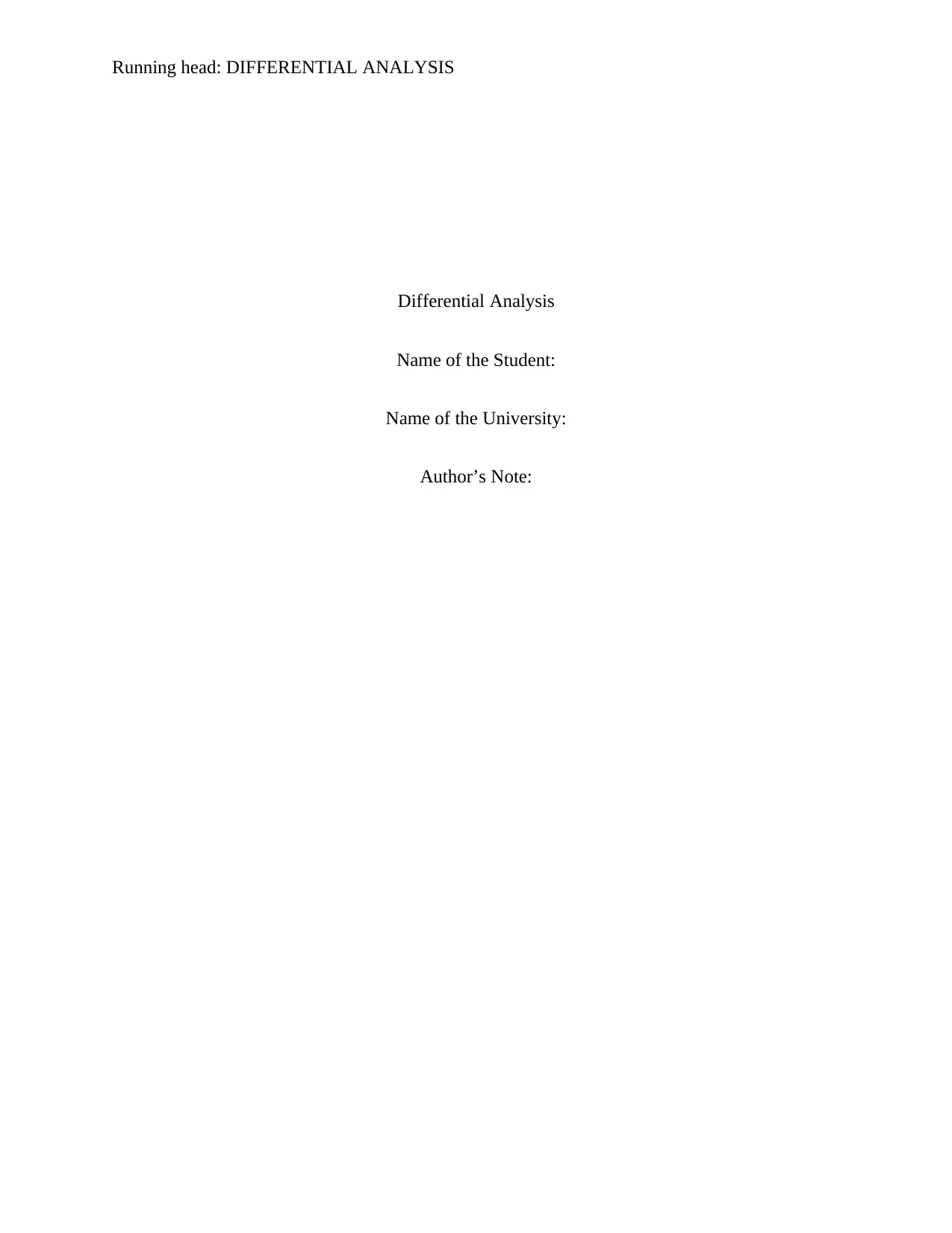
Running head: DIFFERENTIAL ANALYSIS
Differential Analysis
Name of the Student:
Name of the University:
Author’s Note:
Differential Analysis
Name of the Student:
Name of the University:
Author’s Note:
Paraphrase This Document
Need a fresh take? Get an instant paraphrase of this document with our AI Paraphraser
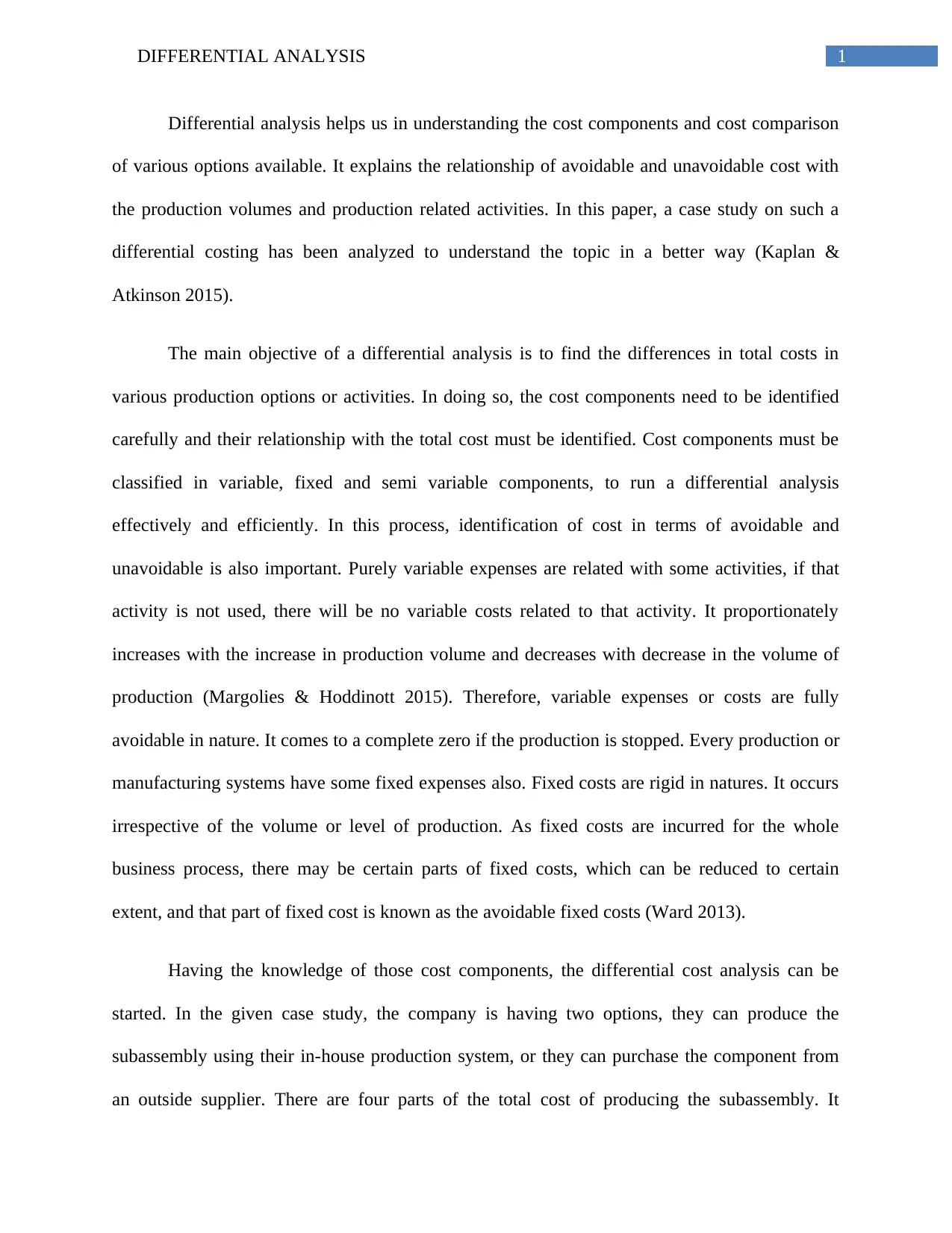
1DIFFERENTIAL ANALYSIS
Differential analysis helps us in understanding the cost components and cost comparison
of various options available. It explains the relationship of avoidable and unavoidable cost with
the production volumes and production related activities. In this paper, a case study on such a
differential costing has been analyzed to understand the topic in a better way (Kaplan &
Atkinson 2015).
The main objective of a differential analysis is to find the differences in total costs in
various production options or activities. In doing so, the cost components need to be identified
carefully and their relationship with the total cost must be identified. Cost components must be
classified in variable, fixed and semi variable components, to run a differential analysis
effectively and efficiently. In this process, identification of cost in terms of avoidable and
unavoidable is also important. Purely variable expenses are related with some activities, if that
activity is not used, there will be no variable costs related to that activity. It proportionately
increases with the increase in production volume and decreases with decrease in the volume of
production (Margolies & Hoddinott 2015). Therefore, variable expenses or costs are fully
avoidable in nature. It comes to a complete zero if the production is stopped. Every production or
manufacturing systems have some fixed expenses also. Fixed costs are rigid in natures. It occurs
irrespective of the volume or level of production. As fixed costs are incurred for the whole
business process, there may be certain parts of fixed costs, which can be reduced to certain
extent, and that part of fixed cost is known as the avoidable fixed costs (Ward 2013).
Having the knowledge of those cost components, the differential cost analysis can be
started. In the given case study, the company is having two options, they can produce the
subassembly using their in-house production system, or they can purchase the component from
an outside supplier. There are four parts of the total cost of producing the subassembly. It
Differential analysis helps us in understanding the cost components and cost comparison
of various options available. It explains the relationship of avoidable and unavoidable cost with
the production volumes and production related activities. In this paper, a case study on such a
differential costing has been analyzed to understand the topic in a better way (Kaplan &
Atkinson 2015).
The main objective of a differential analysis is to find the differences in total costs in
various production options or activities. In doing so, the cost components need to be identified
carefully and their relationship with the total cost must be identified. Cost components must be
classified in variable, fixed and semi variable components, to run a differential analysis
effectively and efficiently. In this process, identification of cost in terms of avoidable and
unavoidable is also important. Purely variable expenses are related with some activities, if that
activity is not used, there will be no variable costs related to that activity. It proportionately
increases with the increase in production volume and decreases with decrease in the volume of
production (Margolies & Hoddinott 2015). Therefore, variable expenses or costs are fully
avoidable in nature. It comes to a complete zero if the production is stopped. Every production or
manufacturing systems have some fixed expenses also. Fixed costs are rigid in natures. It occurs
irrespective of the volume or level of production. As fixed costs are incurred for the whole
business process, there may be certain parts of fixed costs, which can be reduced to certain
extent, and that part of fixed cost is known as the avoidable fixed costs (Ward 2013).
Having the knowledge of those cost components, the differential cost analysis can be
started. In the given case study, the company is having two options, they can produce the
subassembly using their in-house production system, or they can purchase the component from
an outside supplier. There are four parts of the total cost of producing the subassembly. It
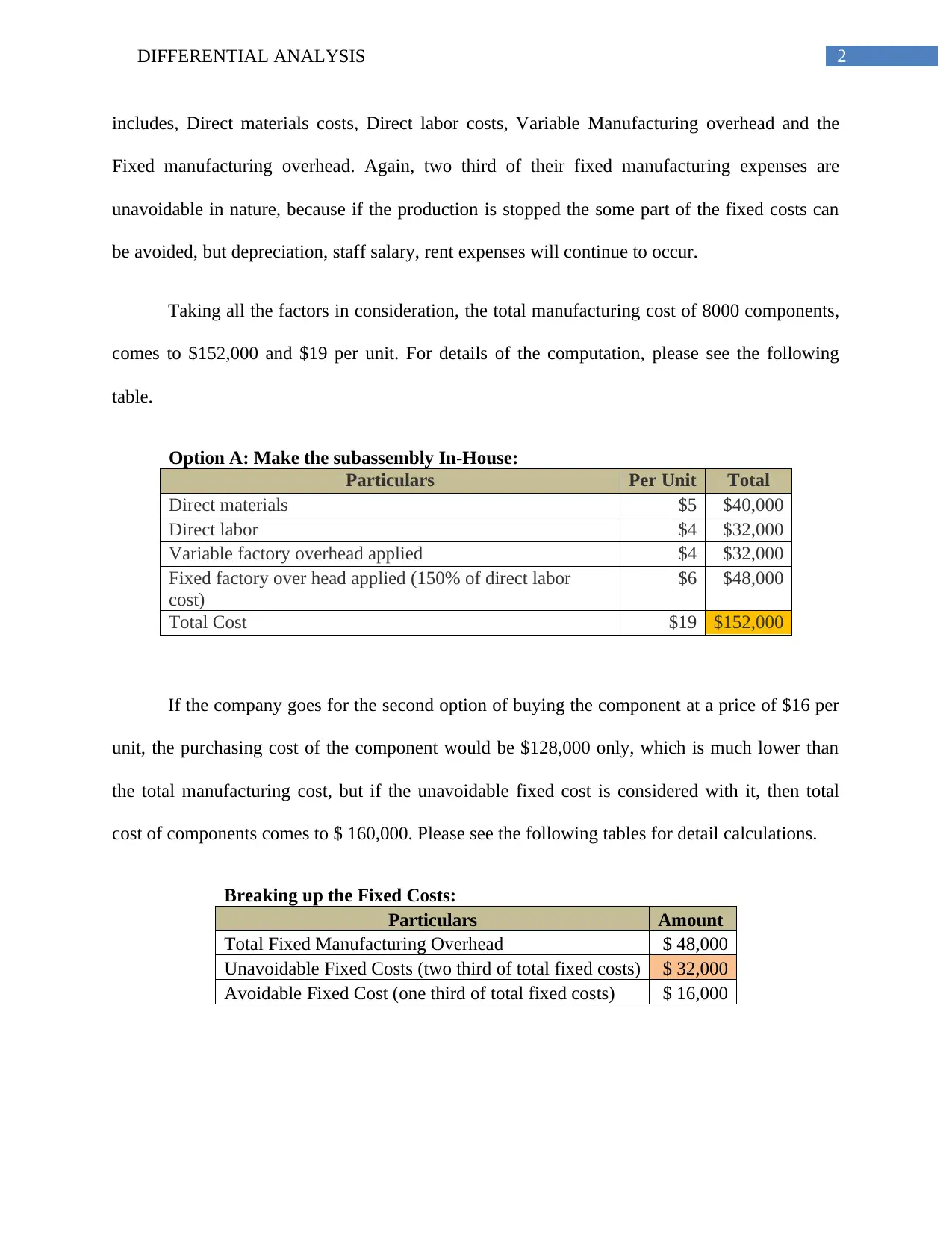
2DIFFERENTIAL ANALYSIS
includes, Direct materials costs, Direct labor costs, Variable Manufacturing overhead and the
Fixed manufacturing overhead. Again, two third of their fixed manufacturing expenses are
unavoidable in nature, because if the production is stopped the some part of the fixed costs can
be avoided, but depreciation, staff salary, rent expenses will continue to occur.
Taking all the factors in consideration, the total manufacturing cost of 8000 components,
comes to $152,000 and $19 per unit. For details of the computation, please see the following
table.
Option A: Make the subassembly In-House:
Particulars Per Unit Total
Direct materials $5 $40,000
Direct labor $4 $32,000
Variable factory overhead applied $4 $32,000
Fixed factory over head applied (150% of direct labor
cost)
$6 $48,000
Total Cost $19 $152,000
If the company goes for the second option of buying the component at a price of $16 per
unit, the purchasing cost of the component would be $128,000 only, which is much lower than
the total manufacturing cost, but if the unavoidable fixed cost is considered with it, then total
cost of components comes to $ 160,000. Please see the following tables for detail calculations.
Breaking up the Fixed Costs:
Particulars Amount
Total Fixed Manufacturing Overhead $ 48,000
Unavoidable Fixed Costs (two third of total fixed costs) $ 32,000
Avoidable Fixed Cost (one third of total fixed costs) $ 16,000
includes, Direct materials costs, Direct labor costs, Variable Manufacturing overhead and the
Fixed manufacturing overhead. Again, two third of their fixed manufacturing expenses are
unavoidable in nature, because if the production is stopped the some part of the fixed costs can
be avoided, but depreciation, staff salary, rent expenses will continue to occur.
Taking all the factors in consideration, the total manufacturing cost of 8000 components,
comes to $152,000 and $19 per unit. For details of the computation, please see the following
table.
Option A: Make the subassembly In-House:
Particulars Per Unit Total
Direct materials $5 $40,000
Direct labor $4 $32,000
Variable factory overhead applied $4 $32,000
Fixed factory over head applied (150% of direct labor
cost)
$6 $48,000
Total Cost $19 $152,000
If the company goes for the second option of buying the component at a price of $16 per
unit, the purchasing cost of the component would be $128,000 only, which is much lower than
the total manufacturing cost, but if the unavoidable fixed cost is considered with it, then total
cost of components comes to $ 160,000. Please see the following tables for detail calculations.
Breaking up the Fixed Costs:
Particulars Amount
Total Fixed Manufacturing Overhead $ 48,000
Unavoidable Fixed Costs (two third of total fixed costs) $ 32,000
Avoidable Fixed Cost (one third of total fixed costs) $ 16,000
⊘ This is a preview!⊘
Do you want full access?
Subscribe today to unlock all pages.

Trusted by 1+ million students worldwide
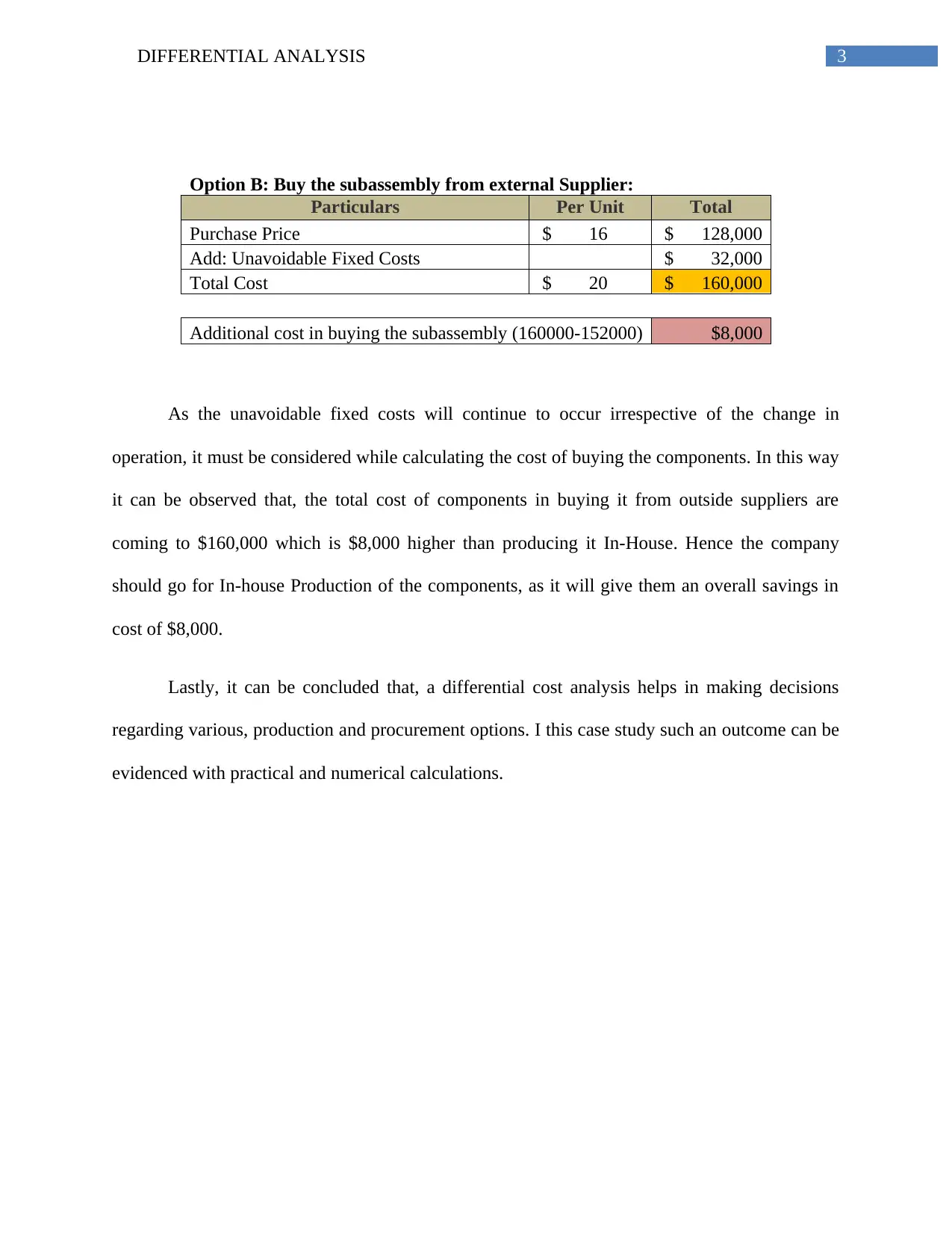
3DIFFERENTIAL ANALYSIS
Option B: Buy the subassembly from external Supplier:
Particulars Per Unit Total
Purchase Price $ 16 $ 128,000
Add: Unavoidable Fixed Costs $ 32,000
Total Cost $ 20 $ 160,000
Additional cost in buying the subassembly (160000-152000) $8,000
As the unavoidable fixed costs will continue to occur irrespective of the change in
operation, it must be considered while calculating the cost of buying the components. In this way
it can be observed that, the total cost of components in buying it from outside suppliers are
coming to $160,000 which is $8,000 higher than producing it In-House. Hence the company
should go for In-house Production of the components, as it will give them an overall savings in
cost of $8,000.
Lastly, it can be concluded that, a differential cost analysis helps in making decisions
regarding various, production and procurement options. I this case study such an outcome can be
evidenced with practical and numerical calculations.
Option B: Buy the subassembly from external Supplier:
Particulars Per Unit Total
Purchase Price $ 16 $ 128,000
Add: Unavoidable Fixed Costs $ 32,000
Total Cost $ 20 $ 160,000
Additional cost in buying the subassembly (160000-152000) $8,000
As the unavoidable fixed costs will continue to occur irrespective of the change in
operation, it must be considered while calculating the cost of buying the components. In this way
it can be observed that, the total cost of components in buying it from outside suppliers are
coming to $160,000 which is $8,000 higher than producing it In-House. Hence the company
should go for In-house Production of the components, as it will give them an overall savings in
cost of $8,000.
Lastly, it can be concluded that, a differential cost analysis helps in making decisions
regarding various, production and procurement options. I this case study such an outcome can be
evidenced with practical and numerical calculations.
Paraphrase This Document
Need a fresh take? Get an instant paraphrase of this document with our AI Paraphraser
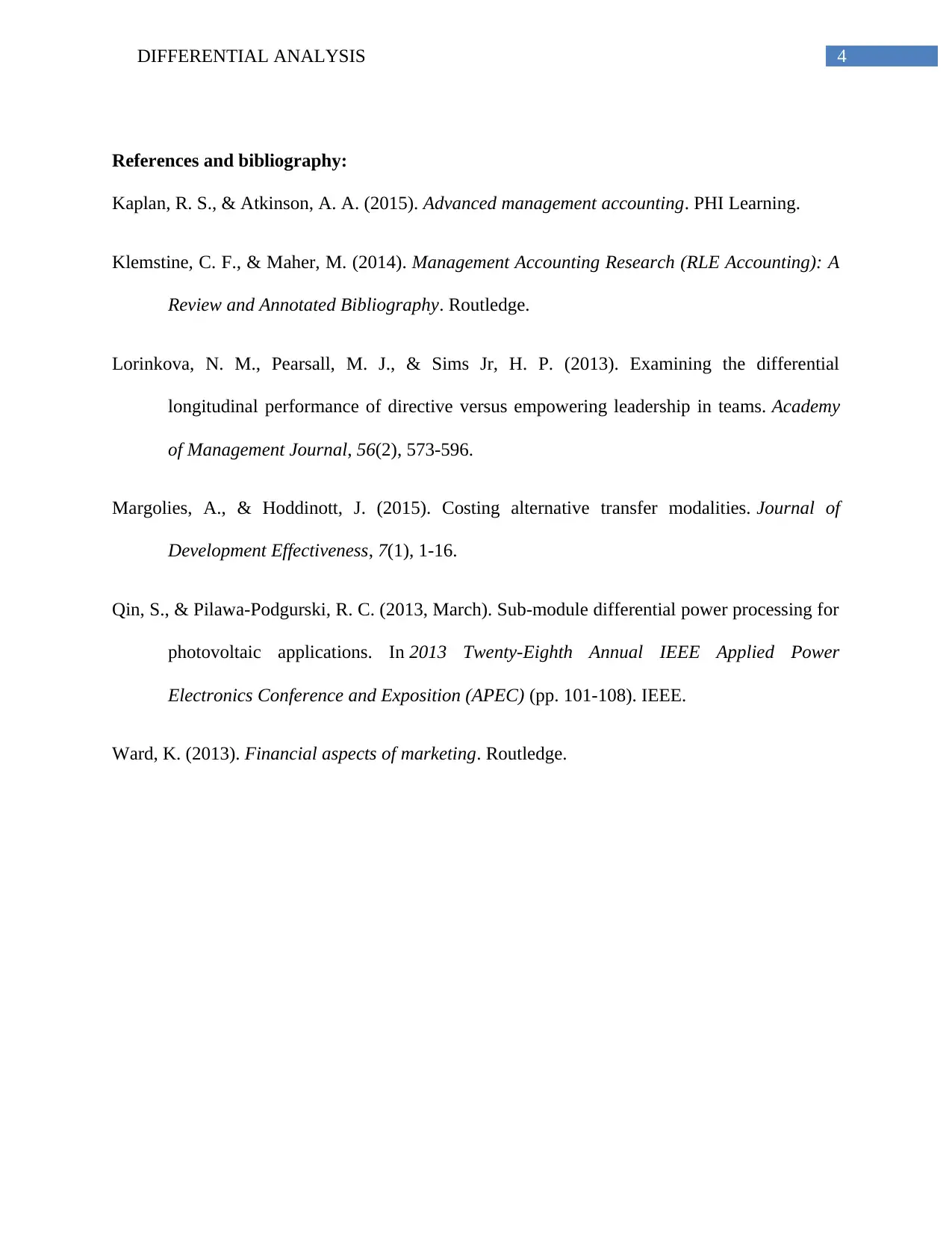
4DIFFERENTIAL ANALYSIS
References and bibliography:
Kaplan, R. S., & Atkinson, A. A. (2015). Advanced management accounting. PHI Learning.
Klemstine, C. F., & Maher, M. (2014). Management Accounting Research (RLE Accounting): A
Review and Annotated Bibliography. Routledge.
Lorinkova, N. M., Pearsall, M. J., & Sims Jr, H. P. (2013). Examining the differential
longitudinal performance of directive versus empowering leadership in teams. Academy
of Management Journal, 56(2), 573-596.
Margolies, A., & Hoddinott, J. (2015). Costing alternative transfer modalities. Journal of
Development Effectiveness, 7(1), 1-16.
Qin, S., & Pilawa-Podgurski, R. C. (2013, March). Sub-module differential power processing for
photovoltaic applications. In 2013 Twenty-Eighth Annual IEEE Applied Power
Electronics Conference and Exposition (APEC) (pp. 101-108). IEEE.
Ward, K. (2013). Financial aspects of marketing. Routledge.
References and bibliography:
Kaplan, R. S., & Atkinson, A. A. (2015). Advanced management accounting. PHI Learning.
Klemstine, C. F., & Maher, M. (2014). Management Accounting Research (RLE Accounting): A
Review and Annotated Bibliography. Routledge.
Lorinkova, N. M., Pearsall, M. J., & Sims Jr, H. P. (2013). Examining the differential
longitudinal performance of directive versus empowering leadership in teams. Academy
of Management Journal, 56(2), 573-596.
Margolies, A., & Hoddinott, J. (2015). Costing alternative transfer modalities. Journal of
Development Effectiveness, 7(1), 1-16.
Qin, S., & Pilawa-Podgurski, R. C. (2013, March). Sub-module differential power processing for
photovoltaic applications. In 2013 Twenty-Eighth Annual IEEE Applied Power
Electronics Conference and Exposition (APEC) (pp. 101-108). IEEE.
Ward, K. (2013). Financial aspects of marketing. Routledge.
1 out of 5
Related Documents
Your All-in-One AI-Powered Toolkit for Academic Success.
+13062052269
info@desklib.com
Available 24*7 on WhatsApp / Email
![[object Object]](/_next/static/media/star-bottom.7253800d.svg)
Unlock your academic potential
Copyright © 2020–2025 A2Z Services. All Rights Reserved. Developed and managed by ZUCOL.




